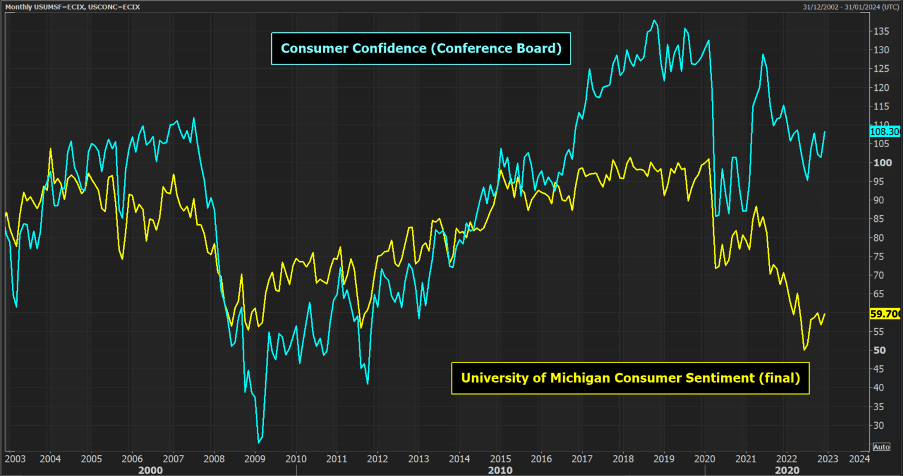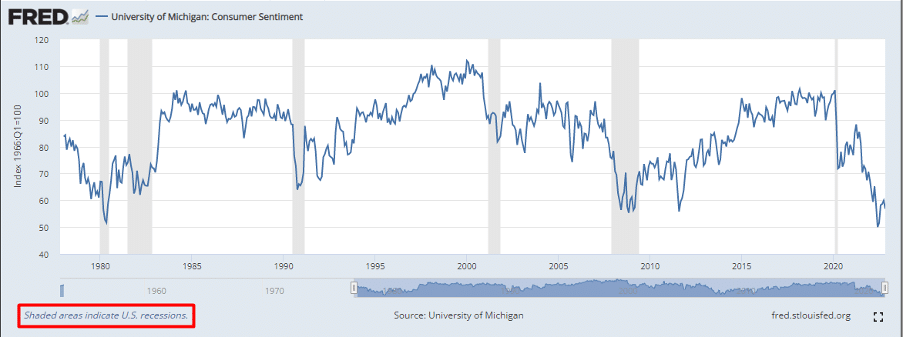What is consumer sentiment?
Consumer sentiment is a measure of the health of an economy from the perspective of the consumer. It is a survey of how optimistic consumers feel about the health of their finances and the economy as a whole.
As an economy matures, consumer spending becomes an increasingly important component of the economy:
- Positive consumer sentiment – If consumers feel more confident of the prospects for the economy and their future, they will feel more secure in their jobs and more confident to spend their money. This increase in consumer spending is a boost to the economy
- Negative consumer sentiment – If consumers are negative about their future economic prospects, they are more likely to spend less and save more. This reduces the demand for consumer goods and services, which impacts the outlook for businesses and the demand for labour.
The two data to watch for on US consumer sentiment
Consumer sentiment is a form of “soft data”. It is data derived from surveys of consumers (rather than actual economic data). In the US, two big consumer sentiment surveys are announced every month:
- US Consumer Confidence – The survey is conducted by the Conference Board (a research organization for businesses). It is a survey that interviews 3000 households. It covers business and employment conditions for now and the next six months. It is announced on the final Tuesday of the month.
- Michigan Sentiment – The University of Michigan Consumer Sentiment is a survey of 500 respondents. It covers a range of consumer issues regarding current and expected areas of the economy including personal finances, business and economic conditions. A preliminary announcement is released mid-month (covering respondents in the first two weeks), whilst a final reading is at the end of the month (covering the whole month of responses).

Reading consumer sentiment… and a caveat
If sentiment is higher compared to the previous month, it would suggest that consumers are more confident and therefore should be more willing to spend their money. The important takeaway from the sentiment gauges is the direction of travel. Also, it is best to look at the data over a series of months, rather than one month in isolation.
The main caveat to the US Consumer Confidence and Michigan Sentiment is the sample size. With a US population of over 330 million people, 75% of which are over the age of 18 (c. 210 million), it is a huge and diverse country (both geographically and socioeconomically). The small sample sizes of just 3000 and 500 people respectively have the potential to throw up erroneous data.
Why is consumer sentiment important?
The consumer plays a vital role in the US economy. A decline in consumer sentiment will tend to reflect an economic downturn and can help to signal a recession. The chart below from the St Louis Federal Reserve shows that each recession since the 1980s has been signalled by a sharp deterioration in consumer sentiment.

Market reaction to consumer sentiment
Trends in the data are important for the macro picture. However, when it comes to trading consumer sentiment gauges, it is all about whether consensus forecasts have been beaten or missed. Market expectations are key for how markets trade the data.
Under normal market conditions, higher than forecast Michigan Sentiment or Consumer Confidence should be:
- Positive for US Treasury bond yields
- Positive for the USD
- Positive for US equities